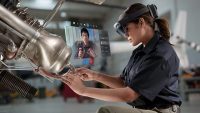Pandemic Is Accelerating the Adoption of Augmented Reality
February 1, 2021
The COVID-19 pandemic is driving increased demand for augmented reality at some companies, including Mercedes-Benz and L’Oréal (whose brands include Lancôme, Kiehl’s and Maybelline New York), in the last year. L’Oréal chief digital officer Lubomira Rochet stated that, “we saw the appetite, it grew and it’s our responsibility now to continue to innovate.” That company has debuted a number of AR projects for employees and customers in the last few months. One uses ModiFace AR to connect consumers with beauty advisers.
The Wall Street Journal reports that, “last summer, L’Oréal also began using Microsoft’s HoloLens 2 headset to help employees install and troubleshoot manufacturing equipment with assistance from experts in different parts of the world.” The HoloLens 2 headset enabled users to “see data, instructions and 3D visual images in their real-world view,” which they could share, via software, with “others who are using a desktop or mobile device.”

At the same time, Mercedes-Benz USA “trained more than 1,200 automotive technicians at all 383 U.S. dealerships …. on how to use HoloLens 2 headsets for remote assistance,” and any technician with a headset can connect with a specialist anywhere in the country. Mercedes-Benz USA vice president of customer service Christian Treiber said that, “now, 60 percent of complex problems can be solved within 24 hours with the HoloLens 2 headset.”
ABI Research reported that, “the worldwide total market value for augmented reality is expected to grow to $140 billion by 2025, up from about $10 billion last year,” a figure that includes “hardware, software and content, AR advertising, platforms and licensing, connectivity and much more.”
Last year, ABI Research reported 1.8 million worldwide shipments of smart glasses, which it predicted will rise to 27 million in 2026. ABI research director Eric Abbruzzese said “the expected growth is attributed partly to the lasting impacts of the pandemic over the next few years … [and] the jolt higher would also be due to new products and advances in the technology over the next few years.”
Vuzix Corp., which makes AR glasses, saw its sales double to $4+ million in last year’s Q4 compared with the same period the previous year. Chief executive Paul Travers said, “this is the beginnings of an inflection point for this industry.”
Microsoft HoloLens principal program manager Charlie Han reported increased demand in auto and semiconductor manufacturing industries. That company “saw a 44-fold rise in remote-assistance usage of HoloLens 2 between January and December of last year,” largely due to COVID-19 restrictions. “It’s not going to be a uniform rocket to the moon, but in some areas we’re seeing extremely fast growth,” said Han.
VentureBeat reports Statista “forecasts that the augmented reality and virtual reality market will hit $72.8 million in 2024, when as many as 43.5 million headsets will be sold.” Next up in development are photorealistic avatars and full-body tracking, although at the 2020 Conference on Computer Vision and Pattern Recognition, a Facebook Oculus division team said that this technology is “years away” for consumer products.

No Comments Yet
You can be the first to comment!
Sorry, comments for this entry are closed at this time.